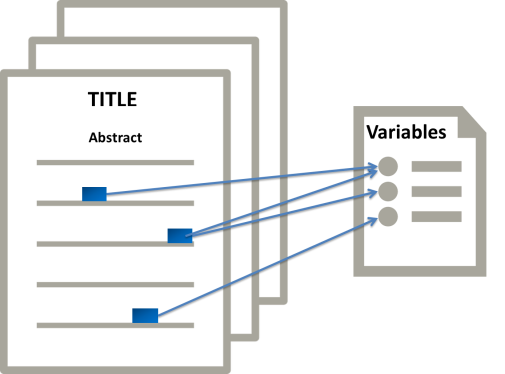For this shared task, a system should be built that can identify all relevant variables from English and
German social science publications given a set of variables and sentences.
The shared task is split into two sub-tasks:
Task 1 - Variable Detection: identifying whether a
sentence contains a variable mention or not.
Task 2 - Variable Disambiguation: identifying which
variable from a given vocabulary is mentioned in a sentence.
We released the training dataset, which contains 4,248 instances for English and German survey variable
mentions. We also released a trial dataset containing 1,227 instances.
Announcements
July 18, 2022: We have released the test data and are evaluating submissions via CodaLab
July 5, 2022: We have extended the registration deadline **until July 14th!** Register here to participate!
June 23, 2022: Registration is now open here
June 8, 2022: Training data is released
March 16, 2022: Trial data is released
November 22, 2021: Workshop is accepted
Contact
Please join our group svident2022@googlegroups.com to receive
announcements and participate in discussions. For any other question, please contact Tornike Tsereteli or Yavuz Selim Kartal.
Important Dates
| Event |
Date |
| Trial Set Release |
March 16, 2022 |
| Training Set Release |
June 6, 2022 |
| Deadline for Registration |
July 4, 2022 |
| Test Set Release (Blind) |
July 18, 2022 |
| System Runs Due |
July 25, 2022 |
| Workshop Papers Due |
August 15, 2022 |
| Camera-Ready Papers Due |
September 5, 2022 |
| Workshop at COLING 2022 |
October 16/17, 2022 |
Data
The dataset is made up of the sentences with and without survey variable
mentions (with their respective variable labels) and a vocabulary of survey variables.
An example of three consequitive sentences is shown below.
(1) A sense of vulnerability and insecurity could create a perception of unmet societal needs, and lead to a
desire for increased welfare state interventions.
(2) In fact, our analyses show that net migration is significantly positively associated with a preference for
greater welfare spending on health, pensions and unemployment.
(3) Our results challenge much conventional wisdom and many scholars and commentators.
In the example, sentences (1) and (3) do not contain variable mentions while sentence (2) contains the
multiple variable mentions (exploredata-ZA4700_Varv25, exploredata-ZA4700_Varv27, exploredata-ZA4700_Varv28).
The variable data is also provided in Table 2.
| id |
label |
question |
item |
answers |
topics |
| exploredata-ZA4700_Varv25 |
v25 - Q7a: Gov. responsibility: Provide job for everyone |
Q.7 On the whole, do you think it should or should not be the government's responsibility to ... |
Q.7a Government responsibility: Provide a job for everyone who wants one |
Definitely should be;Probably should be;Probably should not be;Definitely should not be;Can't choose;No
Answer;Don't know, no answer |
Mass political behaviour, attitudes/opinion;Government, political systems and organisation;Social
stratification and groupings;Economic policy |
| exploredata-ZA4700_Varv27 |
v27 - Q7c: Gov. responsibility: Provide health care for sick |
Q.7 On the whole, do you think it should or should not be the government's responsibility to ... |
Q.7c Government responsibility: Provide health care for the sick |
Definitely should be;Probably should be;Probably should not be;Definitely should not be;Can't choose;No
Answer;Don't know, no answer |
Mass political behaviour, attitudes/opinion;Government, political systems and organisation;Social
stratification and groupings;Economic policy |
| exploredata-ZA4700_Varv27 |
v28 - Q7d: Gov. responsibility: Provide living standard for the old |
Q.7 On the whole, do you think it should or should not be the government's responsibility to ... |
Q.7d Government responsibility: Provide a decent standard of living for the old |
Definitely should be;Probably should be;Probably should not be;Definitely should not be;Can't choose;No
Answer;Don't know, no answer |
Mass political behaviour, attitudes/opinion;Government, political systems and organisation;Social
stratification and groupings;Economic policy |
Table 2: Example survey variables
For the full trial data please visit the SV-Ident GitHub repository.
Evaluation
Task 1:
The variable detection task is evaluated using a standard F1-macro. You can use the evaluation script evaluate_task1.py
to check the
performance of your model.
Task 2:
The variable disambiguation task will be evaluated using (Mean) Average Precision with a cutoff of 10 (MAP@10), which is a measure commonly used in information retrieval and
multi-label text classification.
You can use the evaluation script evaluate_task2.py
(which uses the ranx tool) to
check the performance of your model.
Submission
Rules:
- Please use the most recent version of the dataset (v0.3-train-val-full). If you are using HuggingFace Datasets, make sure that you download the data after July 5th. In case you downloaded the data prior to this, you can delete the cache and then redownload the data or by overwriting the saved data (e.g., load_dataset("vadis/sv-ident", download_mode="force_redownload")).
- Submit the submission file `submission.json` in a ZIP format for each task in the format described below.
- You are allowed to use external data, but must either make the trained model available or provide a script
to train the model (including any external data).
Format:
The submissions should have the following JSON formats:
Task 1
For Task 1, the key is the document ID and the value represents whether the sentence with the document id has
a variable mention (1) or not (0).
Schema:
{
'DOC_ID': 'LABEL',
}
Example:
{
'17': '1',
'238': '0',
...
}
Task 2
For Task 2, the first key is the document ID, the second key the variable ID, and the value the similarity
score
(lower is more similar) for the variable to the document.
Schema:
{
'DOC_ID': {
'VAR_ID': 'SCORE',
},
}
Example:
{
'17': {
'v25': 0.0908927470445633,
'v637': 0.10519161820411682,
'v206': 0.08874139934778214,
...
},
'238': {
'v637': 0.0477452278137207,
'v418': 0.08932048827409744,
'v419': 0.05219722166657448,
...
},
...
}
Organizers
This task is organized by members of the VAriable Detection,
Interlinking and Summarization (VADIS) project.
